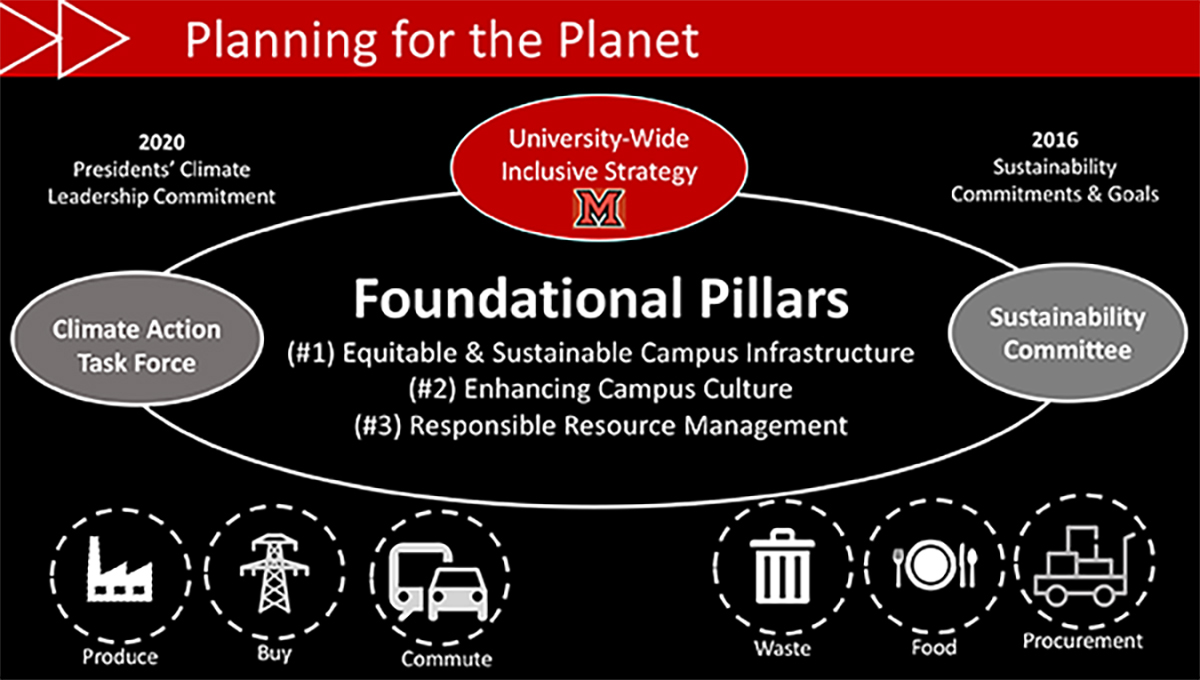Sustainability Annual Report: 52% reduction in energy-based carbon emissions among highlights
Among other highlights: Miami’s forthcoming Climate Action Plan (CAP) will consider social, health, and racial justice issues when developing plans for climate resilience and carbon neutrality; An online student sustainability education module is slated to be implemented in late fall 2021/early 2022.

Sustainability Annual Report: 52% reduction in energy-based carbon emissions among highlights
The Miami University Sustainability Annual Report FY 2021 is now available to view on the Sustainability at Miami website. Read the summary and introduction on the "About" page, under Sustainability Committee Annual Reports.
The report by the Miami University Sustainability Committee provides evidence that the University has met or made significant progress toward the 2016 Sustainability Commitments and Goals (SCAG).
Highlights include:
- Carbon emissions from purchased electricity, natural gas, and coal were reduced from 2008- 2019 by 52% per gross square foot (meeting the SCAG goal for 2030), and 41% independent of gross square feet (meeting the SCAG goal for 2025).
- Miami’s forthcoming Climate Action Plan (CAP) will consider social, health, and racial justice issues when developing plans for climate resilience and carbon neutrality.
- An online student sustainability education module is slated to be implemented in late fall 2021/early 2022.
- Numerous best management practices for grounds maintenance have been implemented, including water conservation using smart technology; and carbon sequestration will be considered when developing the University’s CAP.
- A commitment to transparency is evidenced through reporting to several external platforms, a more robust sustainability webpage, and the development of a carbon footprint dashboard.
The Sustainability Committee recommends that the University retire the 2016 SCAG and establish three Miami University Sustainability Pillars.
“I am looking forward to working with divisional leaders to help establish goals and metrics in support of the new pillars,” Adam Sizemore, director of sustainability, said.
President Gregory Crawford introduced the three pillars at his State of the University Address Sept. 30:
Sustainability Pillar 1: Commitment to an Equitable and Sustainable Campus Infrastructure
Sustainability Pillar 2: Commitment to Enhancing Campus Culture
Sustainability Pillar 3: Commitment to Responsible Resource Management
These Sustainability Pillars will provide a consistent foundation under which each division can establish goals and metrics that can be dynamic, agile, and responsive to constraints and innovations.
Read the Annual Report FY 2021 Executive Summary and Introduction online.
The report was prepared by the Miami University sustainability committee co-chairs Suzanne Zazycki, associate director, Institute for the Environment and Sustainability, and Helaine Alessio, chair and professor of kinesiology, nutrition and health; Adam Sizemore, director of sustainability; and Susan Meikle, news and communications; with members of the sustainability committee.
For a copy of the full 21-page report, contact Adam Sizemore, director of Sustainability, at sizemod3@miamioh.edu or Susan Meikle, News and Communications, at meiklesb@miamioh.edu.

